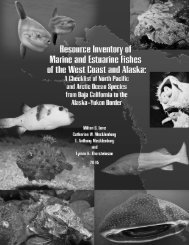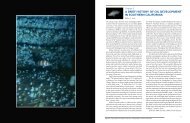Reproductive Ecology and Body Burden of Resident ... - The Love Lab
Reproductive Ecology and Body Burden of Resident ... - The Love Lab
Reproductive Ecology and Body Burden of Resident ... - The Love Lab
You also want an ePaper? Increase the reach of your titles
YUMPU automatically turns print PDFs into web optimized ePapers that Google loves.
Discussion<br />
In general, we observed relatively little evidence <strong>of</strong> conspicuous reproductive impairment in Pacific<br />
s<strong>and</strong>dab from both platforms <strong>and</strong> natural sites. Overall, most fish contained hydrated oocytes <strong>and</strong> were<br />
about to spawn <strong>and</strong> most contained oocytes with smaller yolks <strong>and</strong> thus were likely to spawn again. Many<br />
fish exhibited minor atresia. Atresia is the spontaneous degeneration <strong>of</strong> an oocyte at any stage in its development<br />
<strong>and</strong> it occurs at low frequency throughout the ovarian cycle. For instance, background (i.e., non-test)<br />
levels <strong>of</strong> minor atresia in laboratory-raised zebrafish, Danio rerio, were 58% (Rossteuscher et al. 2008). <strong>The</strong><br />
frequency <strong>of</strong> minor atresia typically increases toward the end <strong>of</strong> the spawning cycle when follicles that initiated,<br />
but did not complete, yolk deposition degenerate (Goldberg, 1981).<br />
We observed relatively few instances <strong>of</strong> pronounced atresia, a condition that is only occasionally observed<br />
in unstressed populations. As an example, pronounced atresia was only found in 2% <strong>of</strong> female Atka<br />
mackerel, Pleurogrammus monopterygius, taken from the relatively pristine Aleutian Isl<strong>and</strong>s (McDermott et<br />
al. 2007). A wide range <strong>of</strong> environmental stressors, including heavy metals (Pierron et al. 2008), endocrine<br />
disrupters (Pollino et al. 2007), <strong>and</strong> starvation <strong>and</strong> lipid-poor diets (Hunter <strong>and</strong> Macewicz 1985; Sherwood<br />
et al. 2007) can cause pronounced atresia. <strong>The</strong> level <strong>of</strong> pronounced atresia we documented was much less<br />
than that found in a study <strong>of</strong> longspine combfish, Zaniolepis latipinnis, <strong>and</strong> yellowchin sculpin, Icelinus<br />
quadriseriatus, from the vicinity <strong>of</strong> sewage outfalls in Santa Monica Bay <strong>and</strong> <strong>of</strong>f Palos Verdes, southern California,<br />
or from a control site in Santa Monica Bay (Cross et al. 1984). That study documented high levels <strong>of</strong><br />
pronounced atresia in 28-49% <strong>of</strong> females from around sewage outfalls <strong>and</strong> 42-44% from a control site (that<br />
was apparently also heavily polluted).<br />
It might be argued that there was some reduction in the reproductive capacity <strong>of</strong> fish from Rincon<br />
as fewer fish from that site harbored 1) hydrated oocytes, 2) those smaller oocytes destined for later spawning,<br />
<strong>and</strong> 3) post-ovulatory oocytes. Furthermore, 16% <strong>of</strong> female Pacific s<strong>and</strong>dab from Rincon contained<br />
ovaries with pronounced atresia. We note that our sample size from Rincon was relatively small, encompassed<br />
only one year, <strong>and</strong> the factors responsible for the reduction in ovarian output in these females remain<br />
to be determined.<br />
Acknowledgments<br />
M. McCrea <strong>and</strong> M. Nishimoto collected the specimens <strong>and</strong> prepared the fish for shipment. We<br />
thank A. Bull <strong>and</strong> D. Schroeder for their support <strong>of</strong> this research. This research was funded by MMS Cooperative<br />
Agreement No.1435-01-05-CA-39315.<br />
76




